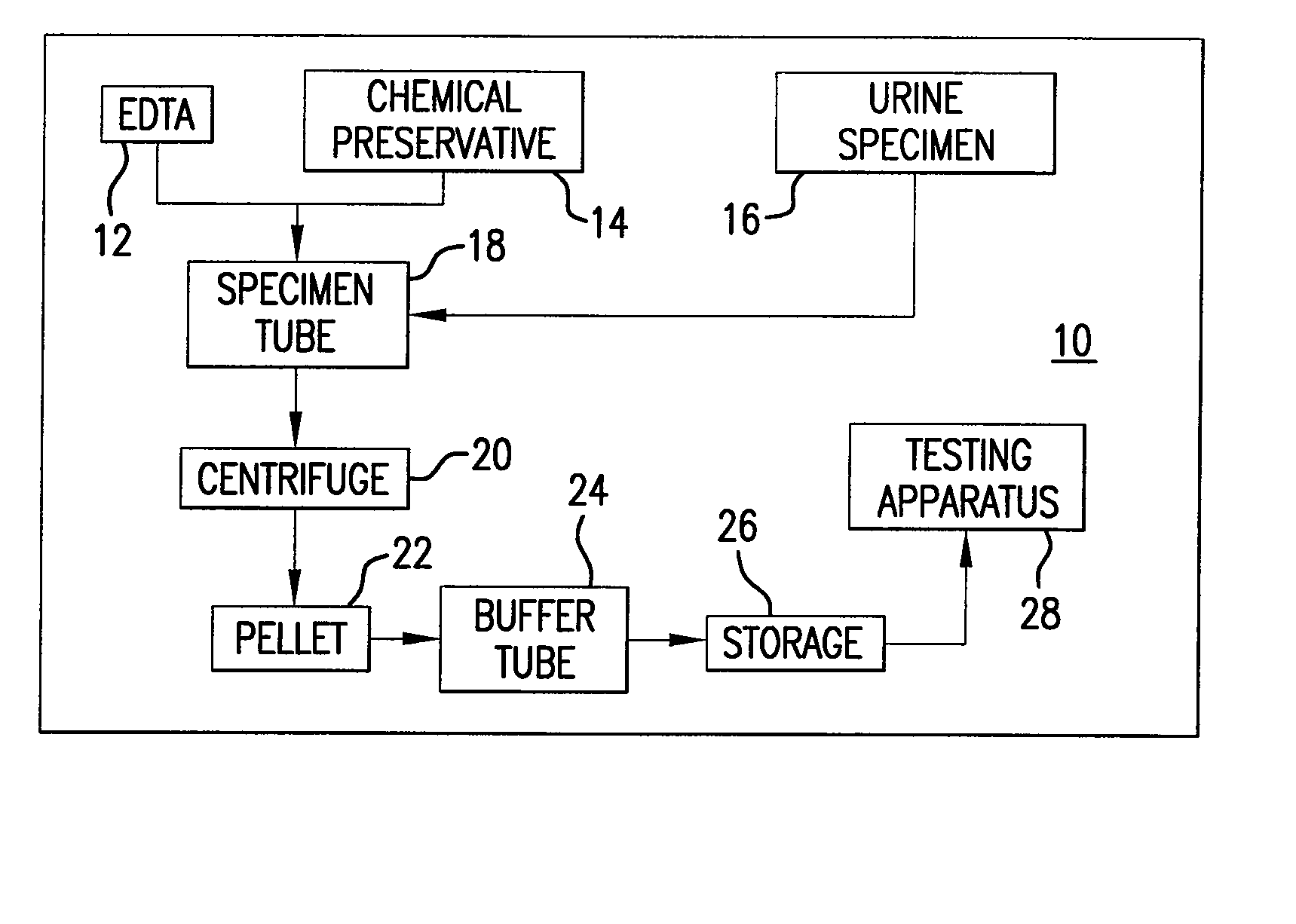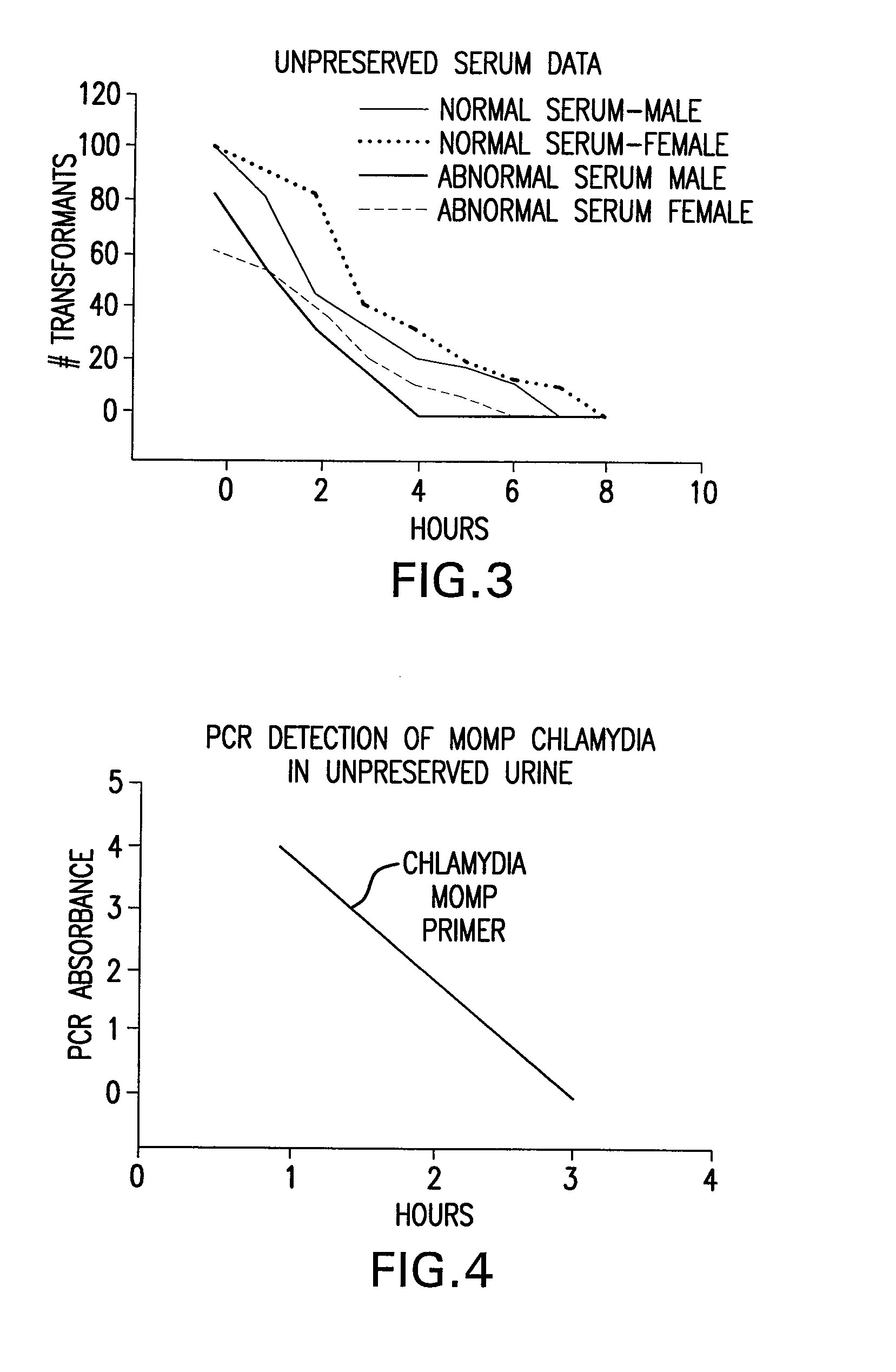Urine Preservation System
a technology of urine and culture results, applied in the field of urine preservation, can solve the problems of not not being easily found in clinical laboratories in many rural or underdeveloped areas, and not always being able to immediately test a patien
- Summary
- Abstract
- Description
- Claims
- Application Information
AI Technical Summary
Benefits of technology
Problems solved by technology
Method used
Image
Examples
example 1
[0117]FIG. 5 is a bar graph of DNA concentration in preserved urine in accordance with the invention. The number of transformants in ten types of urine specimens were tested using a GTT, counted hourly, and then summarized. The standard Gonostat protocol (see Example 2, infra) was employed, and the preservative used was 1 M guanidine HCl / 0.01 M EDTA. A count of two hundred colonies demonstrates total preservation of a specimen. The number of gonococcal transformants in the preserved urine remained relatively constant approaching two hundred, throughout the four hours of the test. No significant difference in level of preservation was observed among the different types of urine specimens. Therefore, it can be seen that the invention provides nearly total protection for DNA in urine.
example 2
[0118]FIG. 6 is a graph of eight day GTT serial data on preserved urine according to the invention. 1 pg of gonococcal DNA was spiked into 9 ml of fresh human urine and 1 ml of aqueous preservative containing 1 M sodium perchlorate and 0.01 M EGTA. 300 μl was spotted onto a lawn of the Gonostat organism at 24 hour intervals for eight days. The plates contained BBL Chocolate II agar and were incubated at 37° C. for 24 hours before readings were taken. The number of colonies observed throughout the eight-day testing period ranged from a low count of one hundred eighty-eight to a high count of one hundred ninety-seven. Thus, it can be seen that the invention preserves DNA in urine for a significantly longer period of time than previously provided.
example 3
[0119]FIG. 7 is a graph comparing PCR results in unpreserved and preserved normal urine according to the invention. A MOMP template to Chlamydia trachomatis was used and amplified using a standard PCR protocol. 200 copies of the MOMP target were spiked into 9 ml of fresh human urine containing 1 M sodium perchlorate and 0.01 M BAPTA. PCR was done each hour for eight hours total. In the unprotected urine, approximately three PCR absorbances were measured one hour after the addition of DNA to the urine. The number of PCR absorbances approached zero by the sixth hour. By contrast, in the preserved specimen, in excess of three PCR absorbances were measured at the one hour testing. However, approximately three PCR absorbances were still observed by the sixth hour. Therefore, the invention preserves sufficient DNA and nucleic acid sequences to permit PCR testing well beyond the testing limits of unpreserved urine. The results shown in the Figure are consistent for all types of DNA in a ur...
PUM
| Property | Measurement | Unit |
|---|---|---|
| Molar density | aaaaa | aaaaa |
| Molar density | aaaaa | aaaaa |
| Molar density | aaaaa | aaaaa |
Abstract
Description
Claims
Application Information
 Login to View More
Login to View More - R&D
- Intellectual Property
- Life Sciences
- Materials
- Tech Scout
- Unparalleled Data Quality
- Higher Quality Content
- 60% Fewer Hallucinations
Browse by: Latest US Patents, China's latest patents, Technical Efficacy Thesaurus, Application Domain, Technology Topic, Popular Technical Reports.
© 2025 PatSnap. All rights reserved.Legal|Privacy policy|Modern Slavery Act Transparency Statement|Sitemap|About US| Contact US: help@patsnap.com



